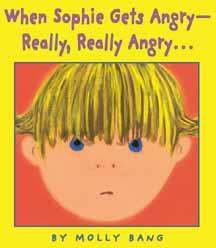| When Sophie gets angry- really, really angry- Author: Bang, Molly | ||
| Price: $16.39 | ||
Summary:
A young girl is upset and doesn't know how to manage her anger but takes the time to cool off and regain her composure.![]() Download a Teacher's Guide
Download a Teacher's Guide
| Accelerated Reader Information: Interest Level: LG Reading Level: 1.40 Points: .5 Quiz: 29508 | Reading Counts Information: Interest Level: K-2 Reading Level: 1.90 Points: 1.0 Quiz: 19650 | |
Awards:
Caldecott Honor, 2000
Common Core Standards
Grade K → Reading → RL Literature → Caldecott Honor Books
CC Maps Recommended Works Gde K-5
Grade K → Reading → RL Literature → K.RL Key Ideas & Details
Grade K → Reading → RL Literature → K.RL Craft & Structure
Grade K → Reading → RL Literature → K.RL Integration of Knowledge & Ideas
Grade 1 → Reading → RL Reading Literature → 1.RL Craft & Structure
Reviews:
Kirkus Reviews (12/15/98)
School Library Journal (+) (01/99)
Booklist (02/01/99)
The Bulletin of the Center for Children's Books (04/99)
Full Text Reviews:
School Library Journal - 01/01/1999 PreS-Gr 2-Sophie is playing with her stuffed gorilla when her sister wrests it from her, knocking her to the floor. When their mother agrees that it is her sister's turn to play with the toy, Sophie becomes so angry that She wants to smash the world to smithereens. She kicks, screams, and eventually runs into the woods where she climbs a huge beech tree, looks out over the water, and is comforted by the wide world. Calm, she returns home ready to participate in family life. The text is appropriately brief, for it is Bang's double-page illustrations, vibrating with saturated colors, that reveal the drama of the child's emotions. Floorboards slant diagonally across two pages, echoing the agitation of the siblings as they engage in a tug of war. A close-up of Sophie's face with blue eyes blazing and pigtails flying is set against a fire-red background. Bang gives the ranting girl a huge red shadow. On the next spread, Sophie releases a ROAR so enormous that she seems to shrink off the page. The trees, outlined in bright red, mimic the girl's anger, then bow down as she passes by stooped and weeping, and finally sport bright-green outlines as she returns home cheered and hopeful. Sophie, like a missing piece, rejoins her family as the puzzle they are working on is completed. Pair this excellent story with Dorothea Lachner's Andrew's Angry Words (North-South, 1995).-Marianne Saccardi, Norwalk Community-Technical College, CT - Copyright 1999 Publishers Weekly, Library Journal and/or School Library Journal used with permission.
Bulletin for the Center... - 04/01/1999 Sophie loses a tug-of-war altercation with her sister over a stuffed monkey, and her anger propels her out of the house and into an anger-reducing run. After running, crying, climbing a tree, and being soothed by the breeze, Sophie feels better and goes home, where everyone is happy to see her. Bang has captured a young child’s uncontrollable eruption of anger in both language (“She kicks. She screams. She wants to smash the world to smithereens”) and images (when Sophie “roars a red, red roar,” she really does). In the scenes where Sophie’s rage is the impetus, the objects in the hotly colored illustrations are outlined in a flaming orange red; as Sophie calms down, the outline changes to a soothing pink, then to cool blues and greens, and finally to the cheerful yellow outlines of the domestic scenes. The double-page spreads are colored in a fiesta palette of warm yellows, saturated blues, and acid greens. In the closing spreads the yellow floors, orange walls, and pink woodwork combine to create a cozy home and hearth, where “everything is back together again and Sophie isn’t angry anymore.” Simple but effective, this title has a cohesive narrative of both words and images that could well be used in storytime programming or to start a discussion of what to do when you’re mad. - Copyright 1999 The Board of Trustees of the University of Illinois.
Booklist - 02/01/1999 There's no shortage of books that deal with children's feelings--the sadness that comes when someone dear dies, jealousy toward a new sibling, disappointment when things don't go as planned--but most couch their explanation in layers of story, and many have a responsive adult adding sage advice. Bang, on the other hand, concentrates first and foremost on the emotion and shows a young child dealing with it strictly on her own terms. The setup is easy to grasp. Sophie becomes angry because she has to give a toy to her sister. When her sister snatches the toy away, causing Sophie to trip, Sophie becomes angrier still. Oh, is Sophie ever angry now! The remainder of the book uses bold graphics, supplemented by a few well-chosen words, to show how anger affects Sophie and what she does about it--from physical expression (She kicks. She screams. She wants to smash the world to smithereens.) and escape (she runs outdoors) to the emotional release (tears and finding a quiet place where the wide world comforts her). The artwork is dynamic. Hot reds, bright yellows and oranges, and jagged shapes that seem to quiver on the page catch the intensity of anger, with Bang softening her palette to more subdued colors as Sophie calms down, and adjusting it back to sunnier ones when Sophie returns home to her loving family. Children may need to be assured that other options besides running outdoors exist for dealing with anger, but that said, Bang's strong, nonproscriptive acknowledgment of a feeling most children will recognize will be welcomed, as will the reassurance that though anger may come, it will also go away given time. (Reviewed February 1, 1999) - Copyright 1999 Booklist.



